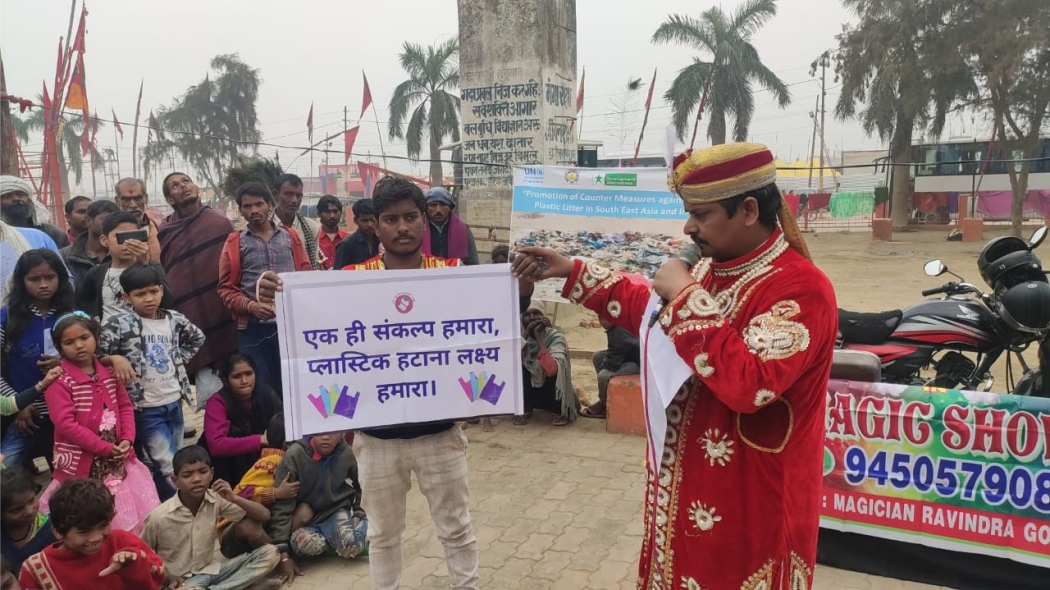|
Today, river pollution is a global phenomenon. There are hardly any rivers in the world that are not polluted. When it comes to Asia, major rivers are heavily polluted (Buriganga (Bangladesh), Yangtze (China), Marilao (Philippines) and Citarum (Indonesia)), and India is not an exception. Ganga river travels the course of 2525 km and plastic pollution in the river can be found at Gaumukh (the source of the river)
It is to be noted that
almost 40% of human civilization is dependent on Himalayan fed river
system and Ganga happens to be a major tributary. According to United
Nations data River Ganga is among the top 10 rivers in Asia to carry 93%
of plastic litter into the ocean alone. Plastic pollution in river is
not a water problem but a civilization problem. Such pollution did not
exist a 100 years ago. Ganga, considered a sacred river, people believe
in washing away their sins if they take a dip in the river. However,
today people are ignorantly disposing plastic into the river with other
spiritual matter. It is not a deliberate act but it is due to lack of
general awareness about plastic usage and disposal. To mitigate the situation, Development Alternatives Group with support from United Nations Environment Programme (UNEP), conducted a perception study to do an analysis of plastic pollution in river ganga which led to developing various programmes focusing on creating awareness, cleaning drives, capacity building in Haridwar (U.K) and Prayagraj (U.P). It was a three-month long programme which started in January and ended in March 2020. The project, Promotion of Countermeasures against Marine Plastic Litter in Southeast Asia and India aimed at reducing the inflow of plastic litter into River Ganga, and develop an interactive process to bring about the change through community intervention. The bigger objective of these agencies and programme is to bring about a behaviour change through involved-interactions. This was achieved through effective communication strategies and systematic information dissemination through interpersonal communication, print-audio-visual as well as new-age media. A systematic one-way and two-way communication model were used to reach maximum stakeholders One-way communication model Targeted stakeholders like religious institutions/leaders, schools, commercial buildings, households, civil society organisations, RWAs were approached to sensitize about plastic pollution in River Ganga. Local language and lingos were incorporated in communication strategy to have maximum impact. Leaflets and brochures were distributed, street-plays were performed at markets and RWAs, and public LED screens were used for broadcasting animated videos designed especially for this programme. National radio channel, All India Radio aired the jingles and radio programmes were run in six districts of Uttarakhand (Dehradun, Haridwar, New Tehri, Uttarkashi, Rudra Prayag, and Chamauli) and multiple places in Prayagraj. A mega event, Humara Sankalp Plastic Mukt Ganga, was organised in Haridwar city. The event aimed at building a common platform for diverse stakeholder to share their opinions and thoughts on the issue of plastics and spread awareness amongst the masses. These various initiatives collectively reached 23 lakh people approximately.
Two-way communication A two-way communication mechanism was also developed where Development Alternatives and other stakeholders had the interactive participation model. Bridging the Information Gap (BIG) sessions were conducted at schools. The objective of the sessions was to build knowledge and create awareness among school children on the menace of plastics in the river, which ultimately causes marine plastic pollution. During the session, students were made aware of the types of plastic thrown into rivers, and its impact on ecology, environment, and economy. Students were taught how to reduce plastic pollution and reduce the usage for a better future. Various videos were shown to drive home the point. Quiz competition were also held in schools to make the sessions interactive. Students were enthusiastic and curious throughout the session and were able to understand the detrimental effects of plastic in rivers. Creative activities were also planned for students called ‘Do It Yourself (DIY)’ via video screening. The video was about ‘how plastic items can be recycled’. The students were aware about the importance of recycling plastics and pledged to reduce plastic pollution in their day-to-day lives. The school principal and teachers of Government Upper Primary School, Jamalpur, Haridwar established an Eco Club comprising ten students. Through these different programmes, approximately 200 students were directly influenced. Clean-up drives were also organized on the banks of River Ganga to gather data on the quantity and types of plastic waste that goes into the river. The data gathered through these programmes was further used to assess the usage pattern of various types of plastic. The idea to have such a diverse means of communication was to reach all the stakeholders (Government officials, religious leaders, media, local community, pilgrims, business owners, students etc.) in the cities who are closely linked with the River Ganga. It was done to deliver the message in the most effective manner which is easily understandable and acceptable by the stakeholders.
Anisha Gupta |

